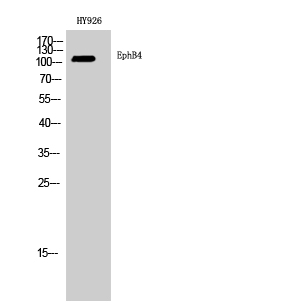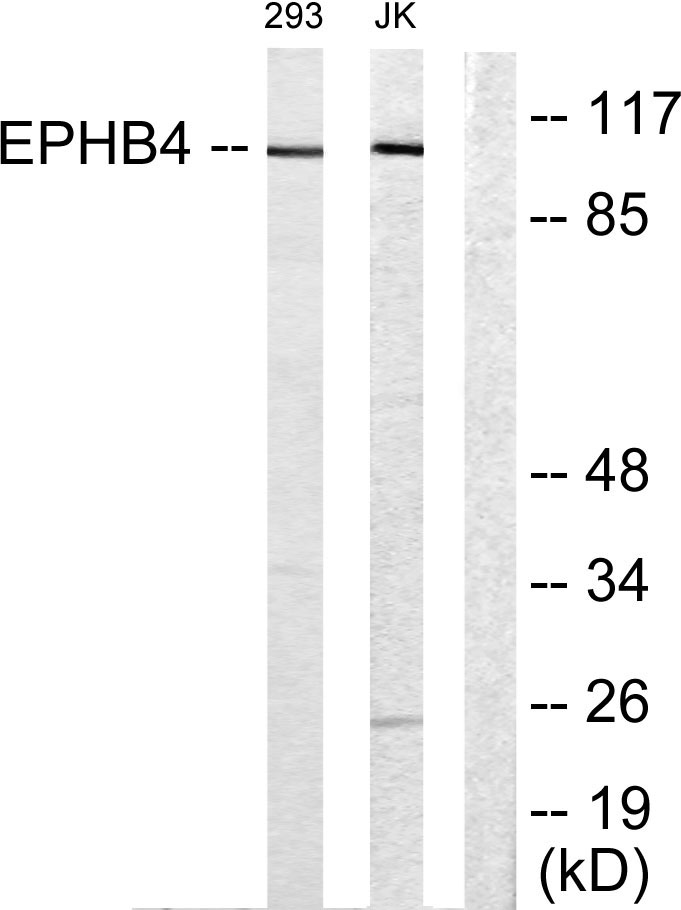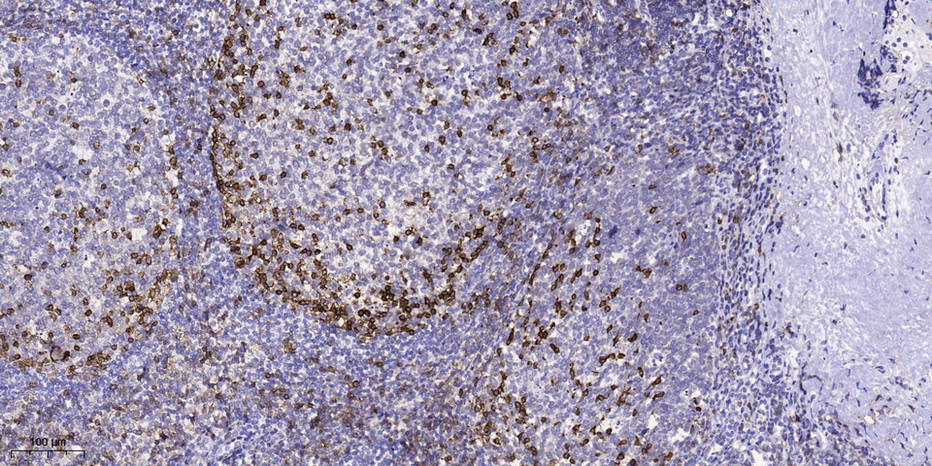EphB4 Polyclonal Antibody
- Catalog No.:YT1587
- Applications:WB;IHC;IF;ELISA
- Reactivity:Human;Mouse
- Target:
- EphB4
- Fields:
- >>Axon guidance
- Gene Name:
- EPHB4
- Protein Name:
- Ephrin type-B receptor 4
- Human Gene Id:
- 2050
- Human Swiss Prot No:
- P54760
- Mouse Gene Id:
- 13846
- Mouse Swiss Prot No:
- P54761
- Immunogen:
- The antiserum was produced against synthesized peptide derived from human EPHB4. AA range:571-620
- Specificity:
- EphB4 Polyclonal Antibody detects endogenous levels of EphB4 protein.
- Formulation:
- Liquid in PBS containing 50% glycerol, 0.5% BSA and 0.02% sodium azide.
- Source:
- Polyclonal, Rabbit,IgG
- Dilution:
- WB 1:500 - 1:2000. IHC 1:100 - 1:300. IF 1:200 - 1:1000. ELISA: 1:20000. Not yet tested in other applications.
- Purification:
- The antibody was affinity-purified from rabbit antiserum by affinity-chromatography using epitope-specific immunogen.
- Concentration:
- 1 mg/ml
- Storage Stability:
- -15°C to -25°C/1 year(Do not lower than -25°C)
- Other Name:
- EPHB4;HTK;MYK1;TYRO11;Ephrin type-B receptor 4;Hepatoma transmembrane kinase;Tyrosine-protein kinase TYRO11
- Observed Band(KD):
- 108kD
- Background:
- Ephrin receptors and their ligands, the ephrins, mediate numerous developmental processes, particularly in the nervous system. Based on their structures and sequence relationships, ephrins are divided into the ephrin-A (EFNA) class, which are anchored to the membrane by a glycosylphosphatidylinositol linkage, and the ephrin-B (EFNB) class, which are transmembrane proteins. The Eph family of receptors are divided into 2 groups based on the similarity of their extracellular domain sequences and their affinities for binding ephrin-A and ephrin-B ligands. Ephrin receptors make up the largest subgroup of the receptor tyrosine kinase (RTK) family. The protein encoded by this gene binds to ephrin-B2 and plays an essential role in vascular development. [provided by RefSeq, Jul 2008],
- Function:
- catalytic activity:ATP + a [protein]-L-tyrosine = ADP + a [protein]-L-tyrosine phosphate.,function:Receptor for members of the ephrin-B family. Binds to ephrin-B2. May have a role in events mediating differentiation and development.,PTM:Autophosphorylated.,similarity:Belongs to the protein kinase superfamily. Tyr protein kinase family.,similarity:Belongs to the protein kinase superfamily. Tyr protein kinase family. Ephrin receptor subfamily.,similarity:Contains 1 protein kinase domain.,similarity:Contains 1 SAM (sterile alpha motif) domain.,similarity:Contains 2 fibronectin type-III domains.,tissue specificity:Abundantly expressed in placenta and in a range of primary tissues and malignant cell lines. Expressed in fetal, but not adult, brain, and in primitive and myeloid, but not lymphoid, hematopoietic cells.,
- Subcellular Location:
- Cell membrane ; Single-pass type I membrane protein .
- Expression:
- Abundantly expressed in placenta but also detected in kidney, liver, lung, pancreas, skeletal muscle and heart. Expressed in primitive and myeloid, but not lymphoid, hematopoietic cells. Also observed in cell lines derived from liver, breast, colon, lung, melanocyte and cervix.
- June 19-2018
- WESTERN IMMUNOBLOTTING PROTOCOL
- June 19-2018
- IMMUNOHISTOCHEMISTRY-PARAFFIN PROTOCOL
- June 19-2018
- IMMUNOFLUORESCENCE PROTOCOL
- September 08-2020
- FLOW-CYTOMEYRT-PROTOCOL
- May 20-2022
- Cell-Based ELISA│解您多样本WB检测之困扰
- July 13-2018
- CELL-BASED-ELISA-PROTOCOL-FOR-ACETYL-PROTEIN
- July 13-2018
- CELL-BASED-ELISA-PROTOCOL-FOR-PHOSPHO-PROTEIN
- July 13-2018
- Antibody-FAQs
- Products Images

- Western Blot analysis of HY926 cells using EphB4 Polyclonal Antibody diluted at 1:2000

- Western blot analysis of lysates from Jurkat and 293 cells, using EPHB4 Antibody. The lane on the right is blocked with the synthesized peptide.

- Immunohistochemical analysis of paraffin-embedded human tonsil. 1, Antibody was diluted at 1:200(4° overnight). 2, Tris-EDTA,pH9.0 was used for antigen retrieval. 3,Secondary antibody was diluted at 1:200(room temperature, 45min).



